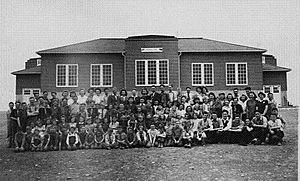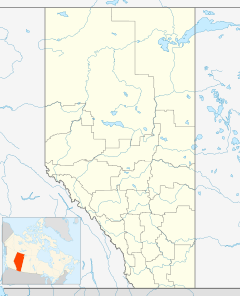Jefferson, Alberta facts for kids
Quick facts for kids
Jefferson
|
|
|---|---|
|
Unincorporated community
|
|

The Jefferson School classes in the 1940s. This building was condemned and deliberately burned to the ground in April 2007.
|
|
| Country | Canada |
| Province | Alberta |
| Region | Southern Alberta |
| Census division | 3 |
| Municipal district | Cardston County |
| Founded | 1899 |
| Area | |
| • Total | .9 km2 (0.3 sq mi) |
| Elevation | 975 m (3,199 ft) |
| Population
(2006)
|
|
| • Total | few |
| Time zone | UTC-7 (MST) |
| Postal code span |
T0K 0K0
|
| Area code(s) | +1-403 |
Jefferson (also known as Owendale) is a small community in Cardston County, Alberta, Canada. It's not a city or town with its own government. Instead, it's part of the larger Cardston County. You can find Jefferson about 16 kilometers (10 miles) southeast of Cardston. Cardston is where the main office for Cardston County is located.
Contents
What is Jefferson Like Today?
Jefferson is a quiet place with just a few services for its residents.
Mail Services in Jefferson
One important service in Jefferson is its postal box outlet. This is a place where people can pick up their mail from special boxes. It's not staffed by postal workers. Jefferson shares the same postal code as Cardston, which is T0K 0K0. Mail for Jefferson is first sent to Cardston. From there, Canada Post delivers it to Jefferson on Mondays, Wednesdays, and Fridays.
In 2003, the old green postal box was damaged. This happened when a nearby abandoned building, the Jefferson Garage, collapsed during a windstorm. A new Canada Post box was then put in place. The old garage had been empty for many years. It was next to what used to be a General Store. That store was changed into a family home a long time ago.
How Jefferson Handles Waste
Another service for the community is the Jefferson Waste Transfer Site. This site was built in the 1980s. It replaced an older, open-air dump. That old dump was located about two miles west of Jefferson in a small valley. The newer Waste Transfer Site is much closer, about a quarter-mile east of Jefferson. It has staff only one day a week.
The new waste site has much stricter rules than the old one. At the old dump, people used to leave all sorts of things, even old cars. Now, waste needs to be prepared in certain ways before it can be dumped. It's then pushed into a dump truck below the building. Many items are not allowed to be dumped at all anymore. This way of managing waste is common in many rural areas across Alberta.
Jefferson's Past: Community and Change
Jefferson has changed a lot over the years. Many of its old community buildings and services are no longer there.
The Jefferson School and Community Hall
There used to be a community hall in Jefferson. This building was originally the Jefferson School in the mid-1900s. It was a busy place, used for community dances and events for the 4-H club, like public speaking contests.
However, in the 1990s, the building started to fall apart. The main problem was leaks in the roof, which ruined the wooden gym floor. By 2007, people broke into the building and caused a lot of damage inside. Because of this, the building was declared unsafe. It was planned to be torn down, but instead, it was burned to the ground on April 24, 2007.
The 4-H Beef Club
The Jefferson 4-H Beef Club also disappeared around the 1990s. 4-H is a youth organization that teaches kids about agriculture, leadership, and life skills. The Jefferson club likely joined with the Chinook 4-H Club in Cardston. This probably happened because many older members grew up and moved away. There weren't enough younger members to keep the club going in Jefferson.
Railroad and Grain Elevator
Jefferson once had its own Wheat Pool elevator. A grain elevator is a tall building used to store grain, like wheat, before it's shipped out. There was also a railroad line that ran through Jefferson.
However, in the early 1980s, the province of Alberta decided to remove some of its less-used railway lines. The railway that went through Jefferson was torn up. This line connected areas east of Cardston, south to Jefferson, and then east to Whiskey Gap, Alberta. The grain elevator was also torn down. This happened when the province started to gather its grain processing in larger towns and cities.


